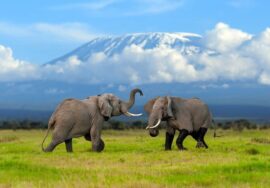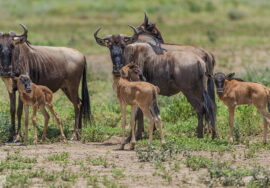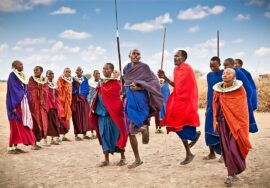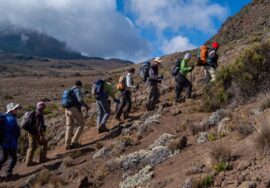
How Hard Is It to Climb Mount Kilimanjaro?
How Hard Is It to Climb Mount Kilimanjaro? Mount Kilimanjaro stands 5,895 meters (19,340 ft) tall and is the world’s tallest freestanding mountain. It is also the tallest mountain in Africa. Maybe you want to know if Mount Kilimanjaro is hard to climb before you go on a trip to this beautiful country.
We’re going to tell you how hard the Kilimanjaro walk is, what to expect, and how to improve your chances of making it to the top. One thing is for sure: the hike isn’t easy, but it’s well worth it.
How Hard Is It To Climb Kilimanjaro?
The answer is easy: yes. A hike up Kilimanjaro isn’t easy for most people. That being said, the routes themselves aren’t too hard. The fact that there aren’t any steep, hard climbs on this trip isn’t the main problem, though.
Dealing with the altitude is the real task. There is only half as much air near the peak as there is at sea level. If you’re not careful, this can really hurt your body.
Low temperatures are another thing that could be a problem. They can drop to pretty low numbers during the hike, which is not what most people think about Africa.
Also, if you want to hike Kilimanjaro, you’ll have to sleep in huts and have very limited access to facilities for at least five to six days.
This means that most people who have done the Kilimanjaro hike agree that it is hard, even if it is not very difficult technically.
How Hard Is Mount Kilimanjaro?
Kilimanjaro’s height
People who hike Kilimanjaro most often have problems with altitude, or more specifically, what happens to the body when it doesn’t get enough air. Four-fifths of the air that is normally available at sea level will be present at the top of Kilimanjaro. It really does take your breath away.
Low levels like these make it more likely that you will get altitude sickness, which can cause a lot of unpleasant (and sometimes dangerous) symptoms, like headaches, nausea, dizziness, and shortness of breath.
Because of this, getting used to the altitude is one of the most important parts of a good attempt. Some people train at high altitudes, which can help them get ready for the hike, but it’s not required.
You can choose a longer route that will take you six to nine days to reach Uhuru Peak. It’s best to give yourself more time. So, your body can slowly get used to having less oxygen and make more red blood cells to help the oxygen get to all parts of the body more efficiently.
This mountain is so high that there is no plants or animals on top of Kilimanjaro. It also means that staying in this environment for long amounts of time is not safe, especially without getting used to it first.
So, if you really want to test yourself on the mountain, you should pick a longer path.
Kilimanjaro Hike Routes
There are eight Kilimanjaro routes leading to the top:
| Route | Distance | Time |
| Umbwe | 53 km (32 miles) | 5 – 7 days |
| The Western Breach | 52 km (32 miles) | 6 – 7 days |
| Shira | 56 km (35 miles) | 6 – 8 days |
| Machame | 62 km (37 miles) | 6 – 7 days |
| Rongai | 70 km (43 miles) | 6 – 7 days |
| Lemosho | 70 km (42 miles) | 7 – 9 days |
| Marangu | 72 km (45 miles) | 5 – 6 days |
| Northern Circuit | 88 km (53 miles) | 8 – 9 days |
Your hike will last anywhere from five to nine days, depending on which one you pick. As we already said, the longer hikes that take 6 or more days are easier and safer for your body. These include Machame, Lemosho, Rongai, and the Northern Circuit.
There are businesses that promote and take short routes, which are popular mostly because they price less. But it’s important to know that the success rate on these treks is much lower than on longer routes, where it can reach 85% to 95%. The success rate on these shorter trips is about 60%.
The Western Breach route is by far the hardest and most dangerous on Kilimanjaro. That’s because it has a steep, rocky hill that has caused bigger avalanches that have hurt at least six people over the years.
The Lemosho path is the best for first-timers because it gives you a lot of time to get used to the altitude and isn’t too difficult to hike. It’s also one of the most beautiful roads.
The Marangu route, which is also known as the Coca-Cola path, is sometimes a good choice for people who have never climbed Kilimanjaro before. The trail has huts instead of tents and is easy enough for people who have never been hiking before. You probably got it: this also makes it one of the busiest hikes.
On any of the Kilimanjaro routes, you don’t need special tools like ropes, harnesses, or knives. This doesn’t mean that this trek doesn’t have any difficult parts. But most of the time, people with different levels of mountaineering skill can do the hike.
Conditions for camping and sleeping
There are also sleeping plans on the Kilimanjaro hike that you should think about. Hikers must sleep in tents on all paths except Marangu. Based on your comfort level and goals, this may be something you want to go through or not at all.
Remember that the hike will last at least five to six days, and during that time you will have to sleep in your sleeping bag on the ground with other walkers. If you don’t like that way, Marangu is the one for you.
There is no access to services like a shower. During your walk, you won’t be able to properly wash yourself, but no one really cares. There are, however, toilets, and they are cleaned regularly, even if some of them might not be in great shape on the busiest lines.
The weather on Kilimanjaro
On Kilimanjaro, the weather is usually pretty good, especially when it’s dry. Between July and October and between December and February is the best and most comfortable time to hike Kilimanjaro.
Even though the mountain is in Africa, the high elevation means that the temperatures will drop really low at night, sometimes as low as -20 degrees Celsius. Because of this, it’s important to be ready for it.
Protective gear, a good sleeping bag with good insulation, and packing and wearing those things can make the trip a lot more comfortable.
Bad weather is always a possibility when mountain climbing at a high elevation, but Kilimanjaro is not what you would expect. However, the good news is that you’ll be hiking with knowledgeable guides who will do everything they can to keep you safe and well.
Your mental and physical health
How fit do you need to be to climb Kilimanjaro? The best way to answer that question is to first understand what kind of activity the Kilimanjaro trip is.
On your hike, you’ll be going on rough, sometimes steep ground for five to nine days in a row.
At such a high elevation, the summit night is one of the hardest parts of the whole trip. You have to walk uphill for a long time. You have to go up and then down in one day. This is the same as hiking for up to 15 hours in pretty tough weather and terrain.
On top of that, climbing Kilimanjaro can be hard on the mind and the heart. You’re far from home and can’t use the comforts you’re used to. You sleep in a tent and get cold, and you have to rely on other campers for help.
Get your mind and body ready for this trip. An intense training plan (at least four days of training sessions to build power and endurance) might help you.
Also, make sure that your drive won’t waver. When planning your walk, make sure you hire a reputable company so you know you’re safe and in good hands.
How hard is it to climb Kilimanjaro? Rates of Success!
As we already said, the longer paths have the best chance of working. A road like Lemosho has a very high success rate of 90%, while the Marangu route, which seems to be more popular, only has a 65% success rate.
About 65% of people who try to climb Mount Kilimanjaro fail.
Would a normal person be able to climb Kilimanjaro?
Yes, Kilimanjaro can be climbed by a normal, healthy person. There are a few things that affect how well you rise.
Good planning and getting ready
Helpful and knowledgeable helper (we’ll take care of that)
Picking a longer hiking trail
Being highly motivated and having a good mood
A quick look at some frequently asked questions
How many people fail to get to the top of Kilimanjaro?
About half to a third of hikers who attempt to reach the top of Mount Kilimanjaro fail. There are a number of reasons for this, but the main one is the altitude and the bad effects that low oxygen levels have on the body.
Is it too late to climb Kilimanjaro at age 50?
Not at all. Anyone who is healthy, busy, and strong enough can climb Kilimanjaro. In this case, age doesn’t matter much.
Should a beginner try to climb Kilimanjaro?
Yes, people who have never hiked before can go up Kilimanjaro. The important thing is to get ready for this test. The person going on the hike should be in good physical shape, ideally having trained for at least two months before the hike.
For some, climbing Kilimanjaro may be one of the hardest things they ever do. But the challenges you face along the way make the experience truly satisfying and unique. From far away, the mountain is very impressive, but the views from the top are truly stunning.
To be successful, you need to give yourself enough time to get used to the mountain and pick a company that has a lot of experience leading Kilimanjaro hike trips.
When you book your Kilimanjaro Package through Tanzania Zanzibar Safari, you’ll get great tents, private cooks, park fees, rescue fees, and a lot more! Our crew knows how to deal with all kinds of problems that might come up on your hike.
We’ll be with you every step of the way and make sure you’re mentally and physically ready to climb Kilimanjaro. Plan your trip now, or get in touch with us if you need more help. We’ll be happy to answer all of them!








